Joseon Dynasty
 From Nwe
From Nwe
|
|||||||||||||||||||||||||||||||||||||||||||||||||||||||||||
Taejo Lee Sung-gye founded Joseon (July 1392 - August 1910) (also Chosun, Choson, Chosŏn) in 1392. The dynasty continued until 1910, lasted for five centuries as one of the world's longest running monarchies. Taejo founded Joseon on the ashes of the Goryeo Kingdom with its capital city Kaesong. Joseon established its capital in Seoul, expanding the kingdom's northernmost borders to the Yalu and Tumen rivers (through the subjugation of the Jurchens). Joseon became the last dynasty of Korea, the longest lasting Confucian dynasty in history. Shortly following the declaration of the Korean Empire in 1897, the dynasty ended with the Japanese annexation in 1910.
Yi Seong-gye, or King Taejo, of the Jeonju clan of Yi, ascended the throne in a coup d'etat against King U of the Goryeo Dynasty. An accomplished military strategist and renowned commander, Taejo had distinguished himself by repelling the marauding Wokou. Taejo took control of Goryeo until July 1392, formally renaming the Goryeo the "Kingdom of Great Joseon" at taking the throne. Taejo relocated the capital to Hanseong (modern-day Seoul) from Gaegyeong (modern-day Gaeseong) in 1394, constructing the Gyeongbokgung palace as the seat of royal power. An unbroken patrilineal succession of kings, a line of descent that continues to the modern era, descended from King Taejo.
Sunjong, the Yungheui Emperor, sat as the last ruling monarch of the Joseon dynasty. Under the Japanese colonial government in Korea, Sunjong became a vassal of the Japanese empire in 1910, losing the title of Emperor and officially ending the Joseon Dynasty. The descendants of Yeongchinwang (Crown Prince Uimin) and Uichinwang (Prince Uihwa), Sunjong's younger brothers make up the surviving bloodlines of the Joseon Dynasty today. The Joseon dynasty saw a consolidation of royal power over Korea, the promotion of Confucian ideals and doctrines in Korean society, an adoption of Chinese culture, and a golden age of classical Korean culture, trade, science, literature, and technology.
Korean dynasties, similar to Chinese dynasties, pass through a birth, golden age, decline, and death cycle. The decline of the Joseon Dynasty began in the late sixteenth and early seventeenth centuries. Successive devastating invasions by neighboring Japan and Qing China weakened the Joseon Dynasty. The decline continued into the eighteenth century when internal strife, power struggles, international pressure and rebellions at home, put the Joseon dynasty on the fast track toward death. Japan successfully cut Korea free from China's protection in 1895 with victory in the First Sino-Japanese War and the Treaty of Shimonoseki. From 1897 to 1910, Japan step by step tightened control, finally ending the Joseon Dynasty in 1910 with the Japan-Korea Annexation Treaty.
The Joseon dynasty passed on a powerful legacy to Korea. Korean etiquette, cultural norms, societal attitudes towards current issues, and even the modern Korean language and its dialects stem from the traditional thought pattern that originated from the Joseon dynasty.
History
Jeulmun Period |
Rise to the throne
By the late fourteenth century, the 400-year-old Goryeo Dynasty established by Wang Geon in 918 tottered, its foundations collapsing from years of war and de facto occupation from the disintegrating Mongol Empire. The legitimacy of the Goryeo became a bone of contention within the royal court. The ruling house failed to govern the kingdom effectively. On top of that, generations of forced intermarriage with the Yuan Dynasty tarnished the royal lineage. Rivalry erupted among family branches, even King U's mother became exposed as commoner, thus leading to rumors disputing his descent from King Gongmin.
Within the kingdom, influential aristocrats, generals, and even prime ministers struggled for royal favor and domination of the court, creating deep divisions between factions. Stepped up raids by Wokou and invasions of the Red Turbans increased to pressure to reform. Reformed-minded Sinjin aristocracy and the opposing Gwonmun aristocracy, as well as successful generals such as Yi Seong-gye and his rival Choe Yeong, rose in popularity. Following pressure from the Ming Dynasty under the charismatic Zhu Yuanzhang (the Hongwu Emperor), the royal court in Goryeo split into two conflicting factions: the group led by General Yi (supporting the Ming Dynasty) and the camp led by General Choi (standing by the Yuan Dynasty).
In 1388 (the 14th year of King U), a Ming messenger demanded the return of a significant portion of Goryeo’s northern territory. General Choi seized the chance to argue for the invasion of the Liaodong Peninsula. Goryeo, claiming to succeed the ancient kingdom of Goguryeo, had long sought to restore Manchuria as part of Korean territory. The royal court chose Yi, although staunchly opposed to the invasion, to lead. At Wuihwa Island on the Yalu River, he revolted and swept back to Gaegyeong (modern-day Gaeseong and the capital of Goryeo), deposing General Choi and his followers. In a coup d'état, Yi overthrew King U in favor of his son, King Chang (1388). Yi later killed King U and his son after a failed restoration, placed a royal named Yo on the throne (he became King Gongyang).
Strengthening his grasp on the royal court through the puppet king, Yi allied with the Jeong Do-jeon and Jo Jun of the Sinjin aristocracy. Yi declared the Gwajeon Law, confiscating land from the land-wealthy and generally conservative Gwonmun aristocrats and redistributed it among Yi's supporters in the Sinjin camp. In 1392 (the 4th year of King Gongyang), Yi's fifth son, Yi Bang-won, assassinated Jeong Mong-ju, a supporter of the old dynasty, eliminating a key figure in the opposition to Yi Seonggye's rule. That same year, Yi dethroned King Gongyang, exiled him to Wonju, and ascended the throne. The Goryeo Dynasty came to an end after 475 years of rule.
Establishing the Joseon Dynasty
King Taejo intended to continue as Goryeo, only changing to royal line of descent from himself. He changed his mind to deal with the Gwonmun nobles and Wang clan who swore allegiance to Goryeo royal line. He sensed the need to clearly break from the past corrupt dynasty, believing that declaring a new dynasty represented to best way to make a clean break. In 1393, King Taejo declared a new dynasty, the Joseon dynasty, reviving the ancient Joseon founded nearly four thousand years previously. The official name, the "Kingdom of Great Joseon," became simply the Yi dynasty.
Taejo and his court still felt concern over what to do with the descendants of the deposed Wang family. The danger of a revolt to restore the Wang line and Goryeo Dynasty remained. Taejo summoned all of the Wang family members to the coast of the Yellow Sea, instructing them to board a ship bound for Ganghwa Island where they would live quietly in exile. Actually a trap, a crew member smashed a hole in the hull in deep waters. The ship sank, drowning the last of the Goryeo Dynasty. Legend has it that relatives of the Wang family on the mainland changed their surnames from Wang (王) to Ok (玉) by adding an extra brush stroke and thus hiding their true descent.
Hanyang the New Capital
Calls came for a new capital, in accordance with the Chinese feng-shui philosophy of geomancy. Three sites came into consideration: the foot of Mount Gyeryong and the cities of Muak and Hanyang. The throne disqualified Mount Gyeryong for the rough terrain and difficulty to communicate with the rest of the country. Taejo decided on Hanyang due to easy access from sea and land, centrality of Hanyang, and the fertile Han River valley. For centuries, Korean geomancers claimed that this location occupied a sacred place flowing with geomantic energy. Hanyang conformed to Sino-Korean tradition. Situated with larger mountains in the north, smaller mountains in the south, and in between a large plain, the city fit the customary north-south axis.
In 1394, Taejo declared Hanyang, renamed "Hanseong," the new capital. That same year, the royal court chose the foot of Mount Bugak to serve as the place for the main palace. Planning and construction of the city with avenues, gates, walls, civilian residences, schools, government buildings, and five main palace complexes also began that year. The construction of Gyeongbok Palace, the official royal residence, finished in 1395 with Changdeok Palace following in 1405. By the mid-fifteenth century, Hanseong had been completed.
Early Royal Family strife
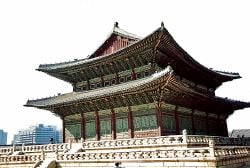
King Taejo had children from two wives. His first wife, Queen Sinui, had six sons before she died. Taejo's second wife, Queen Sindeok, gave birth to two sons. Taejo considered which son would succeed him. Taejo's fifth son by Queen Sineui, Yi Bang-won, seemed a likely candidate since he had contributed most to assisting his father's rise to power. But his rivalry with two key court officials, the prime minister Jeong Do-jeon and Nam Eun, complicated the choice. Jeong Do-jeon used his influence to convince the king that the son that Taejo loved most—not the son that Taejo felt best—would be the right choice for the kingdom.
In 1392, Taejo appointed his eighth son (and the second son of Queen Sindeok), Grand Prince Uian (Yi Bang-seok) the Prince Royal, successor to Taejo. After the sudden death of the queen, Jeong Do-jeon conspired to kill Yi Bang-won and his brothers in order to secure his own position in court. In 1398, upon hearing of this plan, Yi Bang-won raided the palace, killing Jeong Do-jeon, his followers, and the two sons of the late Queen Sindeok. That incident became known as the First Strife of Princes. Aghast at his sons' willingness to kill each other for the crown, King Taejo crowned his second son Yi Bang-gwa, later King Jeongjong, (1357-1419) as the new ruler. Soon after, he departed to the northern city of Hamhung.
As one of King Jeongjong's first acts as monarch, he declared a return to the capital Gaeseong. Yi Bang-won began plotting to become Royal Prince Successor Brother, in the case his brother had no issue. Taejo's fourth son Yi Bang-gan, who too yearned for power, opposed Yi Bang-won's plans. In 1400, Yi Bang-won's faction and Yi Bang-gan's camp erupted into an all-out conflict known as the Second Strife of Princes. Yi Bang-won exiled the defeated Yi Bang-gan to Tosan while his supporters suffered execution. Thoroughly intimidated, King Jeongjong immediately invested Yi Bang-won as heir presumptive and voluntarily abdicated. That same year, Yi Bang-won assumed the throne of Joseon at long last as King Taejong. In 1401, Ming Dynasty of China officially accepted the Joseon Dynasty as a tribute kingdom.
In the beginning of Taejong's reign, the Grand King Former, Taejo, refused to relinquish the royal seal that signified the legitimacy of a king's rule. His father refused to recognize him as a de jure ruler for the execution of family members. Taejong sent several messengers to recover the royal seal, Taejo assassinated every messenger. This episode became known as the Case of the Hamhung Envoys.
Taejong's Reforms
Handicapped without the royal seal, Taejong sought to prove his ability to rule wisely. In one of his first acts as king, he abolished the practice of allowing upper echelons of government and the aristocracy the right to maintain private armies. That move hampered their ability to muster large-scale revolts and dramatically increased the number of men in the national military.
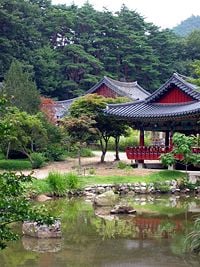
Next, Taejong revised the taxation of land ownership. King Taejong's re-investigation of land ownership in 1405 put an end to the practice of hiding land gained during the redistribution property from Gwonmun aristocrats to members of the Sunjin faction to avoid taxation. That increased the national income two-fold. In addition, King Taejong conducted the first population survey in 1413 ordering the documentation of family names/clans, places of birth/death, and the dates of birth/death for all Korean male subjects. Taejon required all males over the age of 16, regardless of social class, to carry wooden tablets with their name, birth date, and other information engraved. Many historians regard this legislation as the predecessor of the Korean resident identification and social security system. Taejong's new law ensured all men would serve mandatory military service.
In 1399 (the 2nd year of King Jeonjong), Taejong scrapped the Dopyeong Assembly, a council that held a monopoly in court power during the waning years of the Goryeo Dynasty, in favor of the Uijeong Department, a new branch of central administration that carried out the king's edicts. King Taejong issued a new decree that all decisions passed by the Euijeong Department required the king's approval. That ended the practice of court ministers and advisors making decisions among themselves with the king as an onlooker. That raised royal power to new heights. Taejong also installed the Sinmun Office to hear cases of exploitation by government officials or aristocrats.
During the course of Taejong's rule, animosity between the Buddhists and Confucian scholars grew. The new government decided to make Confucianism the state religion. yangban, the class of nobles and scholars, established power during this period.
King Sejong and Hangeul
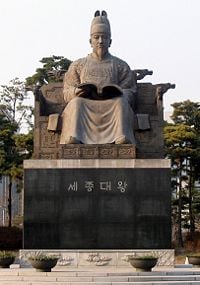
King Sejong created Hangeul (the Korean alphabet) in 1443, to replace the Hanja (Classical Chinese Characters) known in Korea as Hanmun writing systems for official court documents. The Yangban, who had been educated in Classical Chinese, continued to prefer Hanja and Hanmun over the new system of Hangeul, treating those who used of Hangeul with scorn. Not until the late nineteenth century, with the translation of the Bible, did hangeul enter into common usage.
Yangban system
Yangban (i.e, two ruling class, military and government) became the aristocratic class of the Joseon Dynasty. Confucian scholars became yangban by passing a challenging examination, although sometimes the sons of especially esteemed Yangban enjoyed priority. Confucian principles let to establishing a caste system in Joseon with the king at the top of the pyramid, the yangban forming the upper class, a small middle class of government employees known as chungin, the bulk of the population—peasants, laborers and fishermen—classified as sangmin. Sangmin men were taxed for Cho(租)·Pho(布)·Yuk(役). Sometimes heavy tax and corruption of local bureaucrats caused riots.
In theory, any man could become yangban through passing the examination, but few could afford to spend the time and money to study for the required exams. The cheonmin or low-born and slaves sat at the bottom of the social pyramid. People became slaves by birth as well as a form of legal punishment. Slaves served both private persons and the government; government slaves occasionally became citizens of higher rank. Private citizens bequeathed slaves to their heirs as personal property, although slaves could buy their freedom. During times of famine, Sangmin often sold themselves as slaves in order to survive.
The lower classes worked as butchers or shop-keepers, undesirable occupations in Joseon dynasty Korea. The Joseon Dynasty's social hierarchy mirrored that of the Goryeo dynasty. During the fourteenth to the seventeenth centuries, the Joseon class system stood firm and stable. That changed during the eighteenth and nineteenth centuries with the emergence of a new upper class. The caste of Joseon officially ended in 1894. In modern Korean society, the yangban lineage has little or no bearing on a person's success, although people often remember their lineage with pride.
Science and culture
The Joseon Dynasty, as with each of the Korean dynasties, enjoyed a golden age of development. Korean Tea Ceremony and Korean Gardens stand out as two examples of the cultural innovations of the period. The royal dynasty also built fortresses, trading harbors, and palaces. Many Korean inventions come from this period including the first sundial in Asia and the world's first water-powered clock. King Sejong sponsored court scientist Jang Yeong-sil invention of the world's first rain gauge. During the Joseon period, the metal printing press, invented during the Goryeo dynasty in 1232, supplanted the wood-block printing press in China.
Trade and commerce
During the Goryeo Dynasty, Korea had vigorous trade with the Arabians, Japanese, Chinese, and Manchurians. Pyongnam provided an example of a prosperous, international trading port. Koreans traded brocades, jewelries, ginseng, silk, and highly sought after celadon porcelain. Those bluish-green or jade-colored porcelain vases had been crafted by Goryeo artisans, reaching the height of aesthetic beauty. With the advent of Confucian Joseon dynasty, the style of porcelain changed to white, with less adornment, becoming less sought after by the Chinese and the Arabians.
Agriculture took precedence over commerce during the Joseon dynasty, lessening Korea's participation in international trade. China's constant demand for tribute also dampened trade. Korea stopped trading luxury products, like gold and silver from China, opting to import smaller shipments from Japan. China used silver as currency, making the precious metal an important factor in Korea-China trade.
Japan's Korea War (1592-1598)
Main Articles: Japan's Korea War: First Invasion (1592-1596) Japan's Korea War: Second Invasion (1596-1598) Yi Sunsin Turtle ship
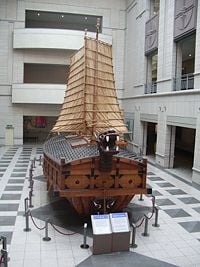
Korea suffered frequent pirate attacks by sea and land. The Korean navy secured the maritime trade against the pirates, achieving advantage over them with the use of cannons and fire arrows using gunpowder, in form of Singijeon deployed by Hwacha (a multiple rocket launcher) borrowed China.
Japanese warlord Toyotomi Hideyoshi invaded Korea with his daimyō and their troops in 1592 and 1597. Factional division in the Joseon court, inability to assess Japanese military capability, and failed attempts at diplomacy led to poor preparation on Joseon's part. Japan's use of European firearms gave them an advantage, leading to the occupation of the southern peninsula within months and the capture of Pyongyang and Hangseong (present-day Seoul).
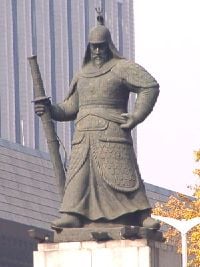
Local resistance slowed down the Japanese advance while Admiral Yi Sunsin's decisive naval victories gave Korea control over Japan's supply routes. Korea's Turtle ships gave Korea the decisive edge in naval battles. Ming China intervened in 1593, pushing the Japanese back to the southern tip of Korea and retreat to Japan.
Japanese invading armies left behind apocalyptic devastation: Farmlands ruined, irrigation dikes destroyed, villages and towns demolished, the population plundered and dispersed, tens of thousands of skilled workers (celadon ware makers, craftsmen, artisans killed or taken captive to Japan. Japan pilfered priceless Joseon historical and royal artifacts, destroyed temples and palaces. The productive capacity of farmlands reduced from 1,708,000 kyol to 541,000 kyol. In 1598 alone, the Japanese took some ears and noses of 38,000 Korean as trophies (a common samurai practice) and built the monument Mimizuka in Kyōto.
Following the war, Korea completely suspended relations. Following Toyotomi Hideyoshi's death in 1598, negotiations between the Korean court and the Tokugawa shogunate began through the Japanese lord on Tsushima. In 1604, Tokugawa Ieyasu restored commercial relations with Korea, meeting Korea's demands and releasing 3000 captive Koreans. In 1607, a Korean mission visited Edo, restoring limited diplomatic and trade relations.
Subsequent history
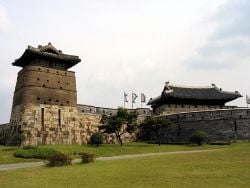
Following those events the Korean Kingdom became increasingly isolationist, seeking to limit contact with foreign countries. The Ming Dynasty fell, partly from the losses in the war against Japan, leading to the establishment of the new Qing Dynasty. The Korean court decided to build tighter borders, exert more controls over inter-border traffic, and wait out the initial turbulence of the Manchu overthrow of the Ming. Despite those measures, Korea conducted extensive trade with Mongolia, Northern Asia, China, and Japan. The king periodically restricted trade with Japan to prevent piracy and maintain orderly trade.
The Manchus invaded Korea twice, in 1627) and 1637. They defeated Korea both times, forcing the kingdom to become a tribute of the Qing dynasty. Qing rulers restricted foreign representatives entrepot to and enclave hongs in Macau. The conducted all trade in silver. These entrepot handled the significant trade of Chinese silks for foreign silver. With foreign trade restricted to the southern provinces, China kept the unstable northern region under strict control. Hence, Korea conducted trade with China solely in the south. Korea benefited from trade with China, trading resources, technology, ceramics and ginseng with receiving China's advanced technology in the exchange. With Korea's economy developing, the first western person, Hendrick Hamel, a Dutchman, stepped on Korea's shores.
Twilight of the Joseon Dynasty
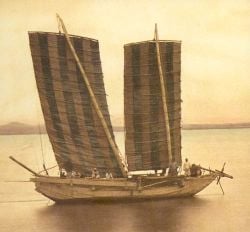
In the nineteenth century tensions mounted between Qing China and Japan, culminating in the First Sino-Japanese War (1894-1895). Japan and China fought much of the war on the Korean peninsula. Japan, after the Meiji Restoration, acquired Western military technology, forced Joseon to sign the Treaty of Ganghwa in 1876. Japan encroached upon Korean territory in search of fish, iron ore, and natural resources. Japan exercised increasing pressure on the royal court, heralding the beginning of Japanese imperial expansion in East Asia.
Japan's victory in 1894 concluded with the Treaty of Shimonoseki guaranteed Korea's independence from China. Korea constructed the Independence Gate, discontinuing tribute payment to the Qing Dynasty court. In 1895, Japanese soldiers assassinated Queen Min, considering her an obstacle to influence and control in Korea. In 1897, King Gojong declared Korea an empire taking the title Emperor Gojong announcing to the world the birth of an independent empire. Unfortunately, Japan knew Korea's true situation, unable to defend itself, and continued intrigue to colonize Korea.
Gojong turned to Russia for military technology needed to defend Korea's independence. Japan noted Russia's growing influence in Korea, taking steps to counter Russia's influence that led to the Russo-Japanese War of 1904. The defeat of Russia left the door wide open for Japan to annex Korea officially in 1910.
The Royal Family Today
After the annexation of Korea in 1910, Japan forced the Princes and Princesses of the Imperial Family to live in Japan for re-education and marriage. The Heir to the Throne, Imperial Crown Prince Uimin, married Princess Yi Bang-ja nee Nashimoto, and had two sons, Princes Yi Jin and Yi Gu. His elder brother, Imperial Prince Ui had 12 sons and nine daughters from various wives and concubines.
The Crown Prince lost his status in Japan at the end of World War II and returned to Korea in 1963 after an invitation by the Republican Government. He never recovered from a stroke suffered as his plane landed in Seoul, dying in 1970. His brother, Imperial Prince Ui had died in 1955. Presently His Highness Prince Yi Seok, a son of Prince Gang of Korea, a fifth son of Gojong of Korea and currently a professor of history lecturing at Jeonju University in the Republic of Korea, is one of two pretenders to the throne of Korea. Many descendants live throughout the United States and Brazil, having settled elsewhere, outside of Korea.
The Imperial Family
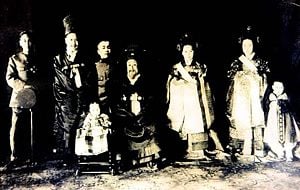
- Emperor Gojong (1852-1919) - 26th head of the Korean Imperial Household
- Emperor Sunjong (1874-1926) - 27th head of the Korean Imperial Household
- Prince Gang (1877-1955)
- Prince Gun (1909-1991)
- Prince Wu (1912-1945)
- Yi Cheong (1936-)
- Prince Gap (1938-)
- Hereditary Prince Imperial Won (1962-) - 30th head of the Korean Imperial Household
- 1st son (1998-)
- 2nd son (1999-)
- Yi Jeong
- Hereditary Prince Imperial Won (1962-) - 30th head of the Korean Imperial Household
- Haewon, Princess of Korea (1919-) - 30th head of the Korean Imperial Household
- Prince Seok (1941-)
- Yi Hong (1976-)
- Yi Jin (1979-)
- Yi Jeonghun (1980-)
- Crown Prince Uimin (1897-1970) - 28th head of the Korean Imperial Household
- Prince Jin (1921-1922)
- Hereditary Prince Hoeun (1931-2005) - 29th head of the Korean Imperial Household
- Princess Deokhye (1912-1989)
- Jeonghye
Titles and styles
During the Kingdom
- King (王 왕 wang), the King, with the style of His Majesty (殿下 전하 jeonha) or, not as correct but yet still quite commonly, His Royal Highness (媽媽 마마 mama). Before the style of "jeon ha" were used a variety of titles for the king. For references to late monarchs the title was Great Predecessor King (先大王 선대왕 seondaewang) or Great King (大王 대왕 daewang); for foreign envoys the title used was State King (國王 국왕 gugwang); and for those in the court who needed to mention the king outside his presence, and thus more formality was required in addressing the monarch, the title was Current King (今上 금상 geum-sang),Sovereign (主上 주상 jusang or 上監 상감 sanggam), or Grand Palace (大殿 대전 daejeon). The style remained the same for all titles with the exception of queen dowagers and the relatively few kings who abdicated, who simply addressed or mentioned the king without using his style.
- Queen Consort (王妃 왕비 wangbi), the Queen Consort, with the style of Her Royal Highness (媽媽 마마 mama). The title used in the court language was Center Palace (中宮殿 중궁전 junggungjeon or 中殿 중전 jungjeon). Queen consorts that remained married to the king until their death were generally given a title consisting of two Hanja in the front and the customary suffix Queen (王后 왕후 wanghu) in the back.
- King Former (上王 상왕 sangwang), a king who has voluntarily abdicated for his son to take his place. They usually remained influential or even powerful through the remaining years of their lives. The style of His Majesty (殿下 전하 jeonha) or, less frequently but yet still quite commonly, His Royal Highness (媽媽 마마 mama) was used.
- Queen Dowager (大妃 대비 daebi), the current incumbent of the throne's mother, with the style of Her Royal Highness (媽媽 마마 mama). Queen dowagers often exercised a great deal of influence on the king's influence through their regencies, which took place when the king was too young to rule in his own name, or simply through their role as the mother or even a senior female relative of the monarch.
- Grand King Former (太上王 태상왕 taesangwang), an abdicated king whose relinquishment of power precedes that of another former king. The style of His Majesty (殿下 전하 jeonha) or, less frequently but yet still quite commonly, His Royal Highness (媽媽 마마 m-ma) was used.
- Royal Queen Dowager (王大妃 왕대비 wangdaebi), a former consort preceding the least senior queen dowager or current King's aunt, with the style of Her Royal Highness (媽媽 마마 mama).
- Grand Royal Queen Dowager (大王大妃 대왕대비 daewangdaebi), a former consort senior to two other queen dowagers or the current King's grandmother, with the style of Her Royal Highness (媽媽 마마 mama).
- Grand Internal Prince (大阮君 대원군 daewongun), the father of a king who was unable to take the throne himself as he was not part of the generation following that of the last incumbent of the throne (kings who are honored at the royal Jongmyo Shrine must be senior generation-wise for the current incumbent to pay homage there). There have been cases when grand chief princes acted as regents for their sons, the last person to do so having been the Regent Heungseon.
- Grand Internal Princess Consort (府大夫人 부대부인 budaebuin), the mother of a king whose father himself never reigned.
- Internal Prince (府院君 부원군 buwongun), the queen consort's father.
- Internal Princess Consort (府夫人 부부인 bubuin), the queen consort's mother.
- Prince (君 군 gun), a son born to the match between the king and a concubine or a descendant of a grand prince. The style used is His Young Highness (아기씨 agissi) before marriage and the style His Excellency (大監 대감 daegam) afterward.
- Princess Consort (郡夫人 군부인 gunbuin), the consort of a prince.
- Grand Prince (大君 대군 daegun), a prince born to the official match between the king and queen with the style of His Young Highness (아기씨 agissi) before marriage and the style His Excellency (大監 대감 daegam) afterward. The title of a grand prince is not inherited and his sons are generally referred to as mere princes.
- Grand Princess Consort (府夫人 부부인 bubuin), the consort of a grand prince.
- Prince Royal (元子 원자 wonja), the firstborn son of the king before being formally invested as heir apparent, with the style of His Royal Highness (媽媽 마마 mama). Generally, Prince Royals were the son who was born first between the king and his official wife, but there were exceptions when the title of Prince Royal was given to the firstborn son of the king through a concubine, the most notable case having occurred in the reign of King Sukjong.
- Royal Prince Successor (王世子 왕세자 wangseja) the heir apparent to the throne, with the eldest son of the king given precedence over his brothers given that there were no major problems with his conduct, with the simplified title Prince Successor (世子 세자 seja) being frequently used instead of the full name with the style of His Royal Highness (邸下 저하 jeoha). In less formal but still official court language, the title Eastern Palace (東宮 동궁 donggung) or Spring Palace (春宮 춘궁 chungung) and the style His Royal Highness (媽媽 마마 mama) was used intermittently with "Prince Successor," although the style was frequently dropped by more senior members of the royal family.
- Royal Princess Successor Consort (王世子嬪 왕세자빈 wangsaejabin), the consort of the heir apparent, or simply Princess Successor Consort (世子嬪 세자빈 saejabin), with the style of Her Royal Consort Highness (마노라 manora or 마누라 manura). Later, as the distinction between "Her Royal Highness" and "Her Royal Consort Highness" became unclear due to the influence of the Andong Kim clan, the style Her Royal Highness (媽媽 마마 mama) also came to apply to the consort of the heir apparent. The style ~ Royal Highness also came to apply to grand princes, princes, and princess as well for the same reason.
- Princess (公主 공주 gongju), the daughter of the official match between the king and his official wife, with the style of Her Young Highness (아기씨 agissi) before marriage and Her Excellency (자가 jaga) afterward.
- Princess (翁主 옹주 ongju), the daughter of the king and one of his concubines, with the style of Her Young Highness (아기씨 agissi) before marriage and Her Excellency (자가 jaga) afterward.
- Royal Prince Successor Brother (王世弟 왕세제 wangseje), the younger brother of the king who has been formally invested as heir presumptive as the king has no offspring.
- Royal Prince Successor Descendant (王世孫 왕세손 wangseson), the son of the Prince Successor and the Princess Successor Consort, and the grandson of the king, with the style of His Highness (閤下 합하 hap-a).
During the Empire
- Hwangje (皇帝 황제), the Emperor, with the style of His Imperial Majesty (陛下 폐하 pyeha)
- Hwanghu (皇后 황후), the Empress (consort), with the style of Her Imperial Majesty
- Hwangtaehu (皇太后 황태후), the Empress Dowager
- Taehwangtaehu (太皇太后 태황태후), the Empress Dowager, current Emperor's living grandmother
- Hwangtaeja (皇太子 황태자), the Crown Prince of the Empire, the eldest son of Emperor, with the style of His Imperial Highness (殿下 전하 jeonha)
- Hwangtaeja-bi (皇太子妃 황태자비), the Crown Princess (consort) of Empire, with the style of Her Imperial Highness
- Chinwang (親王 친왕), the Prince (Imperial), son of Emperor, with the style of His Imperial Highness
- Chinwangbi (親王妃 친왕비), the Princess (Imperial) (consort), with the style of Her Imperial Highness
- Gongju (公主 공주), the Princess of Empire, the daughter of Emperor and his Empress consort, with the style of Her Imperial Highness
- Ongju (翁主 옹주), the Princess of Empire, the daughter of Emperor and one of his concubines, with the style of Her Imperial Highness
References
ISBN links support NWE through referral fees
- Cho, Wan-je, and Hong-gyu Chʻoe. 2000. A cultural history of modern Korea: history of Korean civilization. Elizabeth, NJ: Hollym. ISBN 978-1565911086
- Kang, Jae-eun, and Suzanne Lee. 2006. The land of scholars: two thousand years of Korean Confucianism. Paramus, NJ: Homa & Sekey Books. ISBN 978-1931907309
- Koo, John H., and Andrew C. Nahm. 1997. An introduction to Korean culture. Elizabeth, NJ: Hollym. ISBN 978-1565910867
- Kungnip Chʻunchʻŏn Pangmulgwan. 2002. Our land, our true, view landscape: special exhibition, true, view landscape paintings of Joseon Dynasty. Seoul: Chuncheon National Museum. OCLC 52917695
Credits
New World Encyclopedia writers and editors rewrote and completed the Wikipedia article in accordance with New World Encyclopedia standards. This article abides by terms of the Creative Commons CC-by-sa 3.0 License (CC-by-sa), which may be used and disseminated with proper attribution. Credit is due under the terms of this license that can reference both the New World Encyclopedia contributors and the selfless volunteer contributors of the Wikimedia Foundation. To cite this article click here for a list of acceptable citing formats.The history of earlier contributions by wikipedians is accessible to researchers here:
- Joseon history
The history of this article since it was imported to New World Encyclopedia:
- History of "Joseon Dynasty"
Note: Some restrictions may apply to use of individual images which are separately licensed.
↧ Download as ZWI file | Last modified: 02/04/2023 03:22:03 | 47 views
☰ Source: https://www.newworldencyclopedia.org/entry/Joseon_Dynasty | License: CC BY-SA 3.0
 ZWI signed:
ZWI signed:


 KSF
KSF